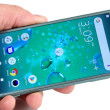Review: Motorola Moto Z2 Force
Aug 2, 2017, 11:00 AM by Eric M. Zeman

The Moto Z2 Force is a semi-rugged — and yet stylish — flagship smartphone from Motorola. This sleek handset boasts dual cameras, top specs, and a nearly unbreakable "ShatterShield" screen. Moreover, it is fully compatible with Motorola's Moto Mods ecosystem of modular accessories and comes with the latest Android software innovations from Motorola. The Z2 Force aims high and will be widely available from U.S. carriers. Despite moving the needle forward, Motorola still managed to bungle at least one aspect of this phone. Here is Phone Scoop's in-depth review.
Is It Your Type?
Motorola's 2017 flagship, the Moto Z2 Force, merges the best parts of its 2016 smartphones into a single handset. If you are invested in Motorola's ecosystem of Moto Mods accessories — or just want a really good high-end phone — the Moto Z2 Force is a fine all-around performer.
Body
The external elements that differentiate last year's Moto Z phones from this year's are few and far between. For all intents and purposes, these phones share most physical design characteristics and basic features, such as their footprint and compatibility with Moto Mods accessories. Only the internal specs, real-world performance, and price tags truly set them apart. The latter is likely the only one of these that matters to consumers standing in a wireless retail shop on any given Saturday. To the naked eye, they all look almost the same.
The 2016 Moto Z was Motorola's design centerpiece, an impossibly thin smartphone that introduced the Moto Mods ecosystem. It was joined by the Moto Z Force, a tougher — but thicker and heavier — smartphone with Motorola's unbreakable ShatterShield technology. Together they delivered a one-two punch, presenting consumers with an impossible choice: sleek and sexy, or brawny and long-lasting.
The Moto Z2 Force, this year's flagship, splits the middle.
Motorola told us that more people opted for the tougher Z Force last year. Given that broken screens are the most common damage sustained by smartphones, the idea of a hardened display appealed to people more so than the razor-thin profile of the Z. Motorola is thus moving forward with a single Z-branded flagship rather than two.
The Z2 Force is a high-end smartphone made mostly of metal. The phone boasts a 2.5D curved front, a rounded metal frame, and a new metal rear plate. I really like the chamfered edges of the frame and the more curved shape that, together, make the Z2 Force comfortable against the palm of your hand. The design of the rear panel, installed within a polycarbonate sub frame, is much like that of the mid-range Z2 Play. The Z2 Force, however, has higher-quality series 7000 aluminum on the rear that is made all the more attractive with a brushed texture. Notably, the Z2 Force does away with the fussy glass panel that covered the rear of last year's phone. This simplifies the design while at the same time unifies its family resemblance with that of the Z2 Play. The phone comes in black, gray (exclusive to T-Mobile), and gold, and each color has its own appeal.

The Z2 Force is smaller and lighter than this year's Z2 Play and last year's Z Force, but that's not saying much. The difference in size here is measured in hundredths of an inch. The Z2 Force is still more than 6 inches tall and about 3 inches wide. The thickness is an appealing 6.1mm, which is beefier than the Z, but trimmer than the Z Force. If there's one dimension that may be off-putting to potential purchasers, it is probably the width. Any phone that stretches across 3 inches is harder to hold no matter how thin a profile it boasts. The Z2 Force may be too large for some, and is often a two-handed phone even for those with larger hands. I found the phone was a fine traveling companion; I never had any trouble cramming it into pockets, packs, or bags.
The materials and build quality are about the best I've seen from Motorola. The plastic and metal body pieces look and feel great. I really like the way the 2.5D panel fits into the metal frame. The same is true of the polycarbonate band that affixes the rear metal plate to the chassis. Motorola eliminated the uncomfortable, sharp edges from last year's model. The Z2 Force stops short of being as impressive as the LG G6 or Samsung Galaxy S8, (both of which have better designs, in my opinion,) but it's clearly a well-made, high-quality piece of hardware.
The Z2 Force carries over the shape of its predecessors, which means it has broadly rounded corners and slightly curved top and bottom edges. The user-facing camera is fairly obvious off to the left of the earpiece, while the two-tone LED flash really stands out to the right.
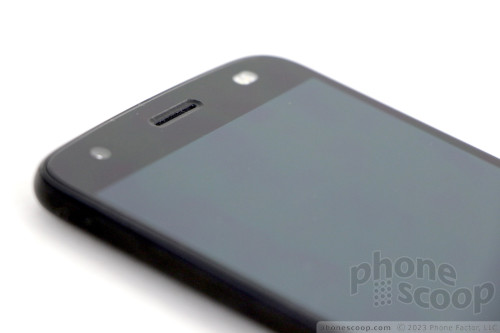
I wish the bezels around the screen were much narrower. They're not bad along the sides, but the non-screen areas above and below the display are much larger than the corresponding areas on the LG G6 and Samsung S8. Motorola has yet to adopt the 2:1 aspect ratio like its competitors. When asked why not, Motorola said it is still evaluating what types of displays could be compatible with the body shape and size that the Moto Mods system requires. Moto didn't rule out 2:1 screens, but seems in no hurry to adopt them.
Like other Moto phones this year, the Z2 Force's fingerprint reader, just below the display, doubles as a navigation tool. You'll need to turn the feature using the Moto App. Once activated, the fingerprint reader acts like a trackpad and allows you to navigate back or access the app switcher when you swipe left or right, respectively. When you turn on the fingerprint reader navigation controls, the screen-based nav buttons go away. This lets you recover screen real estate, but using the fingerprint reader / trackpad for on-screen navigation really takes practice to master.

The remaining physical controls are tucked high on the right edge of the phone. The lowest of the three is the screen lock key. It has a ridged texture to help differentiate it from the other two buttons. I'd call the button a little small, but the travel and feedback are very good. The volume controls are separate buttons above the screen lock key. Motorola put a significant gap between the two, which helps your thumb effortlessly tell them apart. These buttons have smooth profiles and good travel and feedback.
The tray for the SIM and memory cards is on the top edge. The left edge is free from controls. The USB-C port is located on the bottom. There is no 3.5mm headphone jack.

The rear panel is much more attractive than last year's phone, which had a weird, ridged glass panel that I didn't like. The brushed aluminum of the Z2 Force is far more appealing. The camera module has the same size and shape of other Moto Mod-compatible phones, but it has entirely new imaging components within (two lenses and a two-tone flash.) Just like the Z2 Play, the stylized "M" Motorola logo on the Z2 Force is not etched into the metal; rather, it is a plastic insert that ensures the NFC radio can function properly. Motorola did a good job matching the appearance of the plastic insert to that of the surrounding metal.

Motorola's proprietary magnetic module connector is positioned near the bottom of the rear panel. The magnets feel incredibly strong and clingy, though it is still easy to pry Mods off when you want to. Both existing and new Mods fit on the Z2 Force perfectly and securely.

The phone is sealed up tight, so swapping the main battery is not going to happen. Motorola has dedicated battery Mods for those who fret about battery life.
The Z2 Force is not truly waterproof like the G6, S8, or iPhone 7, meaning it cannot sit in 3+ feet of water for 30 minutes. Instead, Motorola has coated the interior electronics with a water-resistant material. When asked about the Z2 Force's lack of full waterproofing, Motorola said the nano coating is protective enough to save the phone from splashing, sweat, rain, and even a really quick dunk in water. In other words, you can drop it in the pool and the phone should be okay if you immediately pull it out and dry it off. Motorola insists this is all the protection the Z2 Force needs from backyard shenanigans.
There's no question Motorola improved the hardware of the Z2 Force when compared to its predecessors. It tweaked the design in just the right ways to give the phone its own personality while keeping the character of the original series intact.

Screen
The Z2 Force has a 5.5-inch quad-HD screen. It's the same size and resolution of last year's phones, but relies on the latest ShatterShield technology from Motorola in order to form a break-proof display. ShatterShield relies on multiple layers of hardened aluminum and plastic. The first-generation ShatterShield appeared on the 2015 Droid Turbo 2 and was rather dim and unimpressive. Motorola has come a long way since then, as the Z2 Force's screen is clearer and brighter. The newest version of ShatterShield allowed me to drop the Z2 Force multiple times onto concrete without any breakage. I wouldn't make a habit of this behavior, but accidental drops shouldn't leave your wallet crying for mercy.
The plastic OLED screen on the Z2 Force is just as good as any leading quad HD display I've reviewed in recent memory. The size/resolution combination delivers razor-sharp text and graphics. Quad HD is the best resolution for VR (right now.) I installed Google's Daydream VR platform on the Z2 Force and it ran really well. I found the display to be plenty bright for indoor use, though you will have to crank it up to view it outdoors. Colors are a touch cool. Viewing angles are pretty good, with just a bit of blue shift when the phone is tilted left or or right.
Signal
The Z2 Force is going to be more widely available than the original, which was a Verizon exclusive. The Moto Z2 Force will be sold by most U.S. carriers (AT&T, Sprint, T-Mobile, U.S. Cellular, Verizon.) Motorola plans to offer unlocked versions of the phone, too, but the unlocked models will be specific for each carrier. In other words, there is no one global unlocked variant. Motorola explained that it had to build specific network technology into the phone for each of the major U.S. carriers in order to properly support forthcoming "Gigabit" LTE service. This means you can buy it unlocked, but you'll have to specify which carrier you use at the time of purchase. That's a bit confusing as far as I am concerned. The phone supports most U.S. LTE bands, including T-Mobile's newer Band 66.
That said, Motorola lent us a Verizon-branded version of the Moto Z2 Force and it performed really, really well. It always found Verizon's network and remained connected to LTE 4G without fail. I was able to make calls on the first dial, and the phone didn't miss any or drop any, even at highway speeds. The phone delivered some of the fastest data speeds I've seen in NYC in recent months. I downloaded 1 GB of app updates over the network in mere minutes. The phone was a data powerhouse. Streaming music via Spotify or video via YouTube TV was a great experience. I never saw any significant slow-downs, buffering, staggering, or low-res performance.
Sound
The Z2 Force is a very good voice phone. The earpiece of the Z2 Force does double duty: it handles regular calls and speakerphone calls. The calls I made via the earpiece were clear and free of distortion. Volume leaves a little to be desired. I was able to hear calls in a small room with a roaring air conditioner, but hearing calls on city streets or in a moving car seemed harder. Those I spoke to through the Z2 Force said I sounded "really good."
The speakerphone isn't quite as good. Voices come through the speaker a bit muffled and volume isn't the greatest. For example, I was better able to hear calls through the earpiece in that room with the air conditioner than I was via the speakerphone, even with the speakerphone volume all the way up. The speakerphone is also somewhat more prone to distortion at full volume. It does okay in a moving car.
Ringers and alert tones were able to get my attention most of the time. I missed several calls when I had the phone in silent mode due to the weak vibrate alert.
Battery
If the Z2 Force has one achilles heel, this is it. The Z2 Force has a relatively small 2,730 mAh battery. (Last year's Z Force had a 3,500 mAh power pack.) Motorola reduced the size of the battery in order to keep the phone's chassis nice and thin. This definitely has a cost.
The Z2 Force cannot make it through a full day under the most intense use. The Z2 Force called it quits by 9 or 10pm on days I played games, shot video, streamed music and movies, and spent lots of time scrolling through Twitter and Instagram. When I backed off some media consumption, the phone was able to get from breakfast to bedtime with some fumes left in the tank. Power users will likely not get a whole day of battery life from this phone. That's not so great.
There are two mitigating factors here.
First, Motorola says battery Mods are the most popular Moto Mods in the ecosystem. Motorola makes a swappable battery pack that adds an extra 3,300 mAh battery and supports rapid charging. I reviewed it earlier this year. It's slim, and delivers the goods when needed. You can use the phone from breakfast until happy hour with the Mod attached, pull the Mod off on the way to dinner, and still have enough power in the phone to take you to last call.
TurboPower Battery Mod
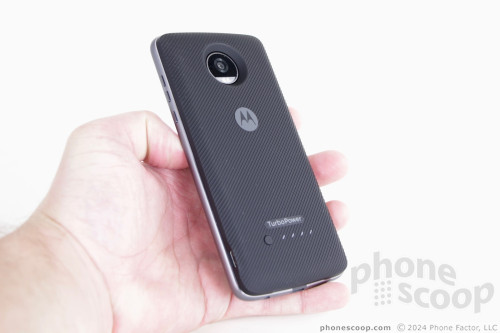
Second, the Z2 Force supports Motorola's TurboPower rapid charging. The company claims 15 minutes on the included charger will give you 8 hours of battery life. That's about right. TurboPower delivers a huge jolt of power in a very short time. What's more, the battery Mod also supports TurboPower, so you can use the Mod battery pack to top up quickly if needed.
By itself, the Z2 Force does not support wireless charging. But Motorola makes a Style Shell with Wireless Charging, which lets you add wireless charging to the handset via Moto Mod.
Style Shell with Wireless Charging
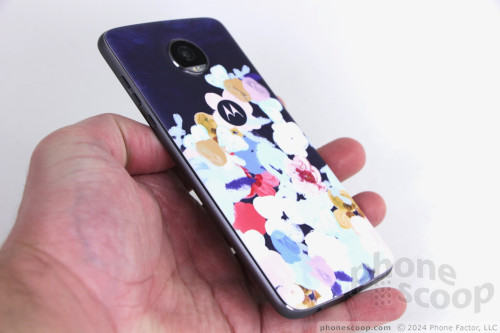
Bluetooth, GPS, NFC, WiFi
I didn't run into any issues with the Z2 Force's secondary radios. Bluetooth delivered swift connections to other devices, such as headsets and speakers. Phone calls sent to headsets and my car's hands-free system were decent, though not the best I've heard. The Z2 Force was able to push files to other phones and PCs. Music streamed to a Bluetooth speaker sounded very good.
Google Maps put the Z2 Force's GPS radio to effective use. The phone often pinpointed my location in a second or two, with accuracy as good as 10 feet. It doesn't get much better than that. The GPS radio and Maps worked in tandem for accurate real-time navigation. The Z2 Play is a fine navigation device when driving or walking around town.
Motorola appears to have vanquished whichever gremlins prevented me from fully using NFC on the Z2 Play, because NFC on the Z2 Force worked as expected. I was able to rely on the NFC radio to initiate Bluetooth pairing, data transfers between phones, and of course use Android Pay.
The Z2 Force has great WiFi.




















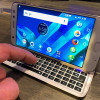 Hands On with the Livermorium Keyboard Slider Moto Mod
Hands On with the Livermorium Keyboard Slider Moto Mod
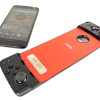 Review: Motorola Moto Gamepad for Moto Z2 Force
Review: Motorola Moto Gamepad for Moto Z2 Force
 Review: Motorola 360 Camera
Review: Motorola 360 Camera
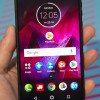 Hands On with the Moto Z2 Force
Hands On with the Moto Z2 Force
 Motorola Updates 5G Moto Mod, Adds Z2 Force Compatibility
Motorola Updates 5G Moto Mod, Adds Z2 Force Compatibility
 Motorola Moto Z2 Force
Motorola Moto Z2 Force




